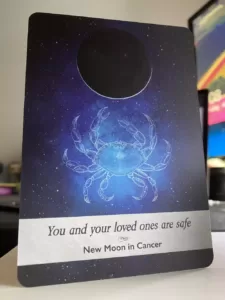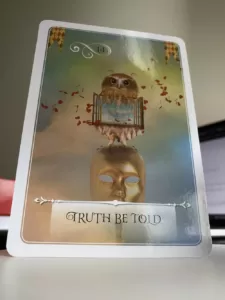If you’re new to Tarot (or cartomancy in general), a common question is: what’s the difference between Tarot vs oracle cards?
If you’re completely new to all this, I can imagine where the confusion stems from. An “oracle” is someone who predicts the future, and Tarot cards are known for supposedly being able to predict the future, so how are oracle cards different from Tarot cards and vice versa?
Fear not! The difference boils down to something quite simple:
Tarot has a pre-determined structure whereas oracle cards do not.
The Structure of the Tarot
What I mean by this is that Tarot is almost always characterized by having:
- 78 cards in total
- 22 cards in the Major Arcana
- 56 Cards in the Minor Arcana
- 16 “Court” cards (e.g. Page, Knight, Queen, King)
- Four suits (e.g. wands, cups, swords, and pentacles)
There are some exceptions to this. Most Tarot card manufacturers print Tarot cards in 80 card sheets so there are usually two “leftover” cards included in the deck, either left blank or some kind of informational card with details about the creator or publisher. However, some creators use these extra two cards to “invent” extra cards, usually extra Major Arcana cards.
Nevertheless, Tarot deck creators often exercise creative freedom in the following ways:
- Different suits other than the traditional wands, cups, swords, and pentacles
- Different Court cards other than traditional Page, Knight, Queen, and King
- Different order of the Major Arcana (sometimes Strength and Justice are switched around)
- DIfferent titles for cards in the Major Arcana
- Whether or not there are scenes on the “pip cards”
- Artistic freedom (obviously)
Despite all these creative liberties, Tarot decks are immediately recognizable in virtue of their shared structure (78 cards, 22 Major Arcana, etc.)
Oracle Cards
In contrast, there is no set structure for oracle cards.
They might have 50 cards or 10 or 30 or 300. Nothing is off-limits, in theory.
Also, Oracle cards vary widely in their format and structure. For example, the lovely Moonology oracle deck [affiliate link] is 44 cards with different types of moons in different moon phases.
Compare that to the fantastic 50-card Wisdom of the Oracle oracle deck [affiliate link] that blends together Tarot and other divination systems into a unique divination tool:
The author describes the card’s essential meaning as “Honesty; accepting things at face value; coming out of denial; the willingness to be transparent; clarity of communication.” As you can see, “Truth Be Told” as a symbolic concept does not directly correspond with any single card in the Tarot.
This is common to Oracle Cards. They use symbolism and concepts that are different from Tarot to communicate ideas that are only alluded to indirectly in the Tarot.
It’s not that a Tarot reading could never suggest honesty; it’s just that by having a card that is straight-up about honesty emphasizes that concept directly in a way the Tarot never could.
Another feature that makes Oracle cards unique is often Oracle deck authors can get quite creative in the “guidebooks” that come along with the decks. They can include divinatory meanings or keywords like Tarot decks, but they can also suggest rituals, or methods, or invocations, or prayers, or generally be way more flexible in how they offer guidance than your typical Tarot book, which is often more structured and follows tradition in many ways (though there are, of course, exceptions to this.)
This makes Oracle cards useful as a complement to Tarot. This takes me to my next point.
Which is better: Tarot Cards or Oracle Cards?
For me, I reject the premise behind the question because it’s like comparing apples and oranges. They are different tools that serve different purposes.
While some people might be drawn to the simplicity and directness of oracle cards, others might be drawn to the esoteric mystery inherent to so much of the Tarot symbolism.
Some people might care about the historical ancestry of Tarot, the idea that it’s been used for divination and occult purposes for hundreds of years. This gives it a certain “weight,” although we must be cautious about projecting too far back into time since the occult usage of the Tarot only dates back a few centuries, not thousands of years as some myths hold.
Another famous oracle system is Lenormand, which is a cartomancy system that is old and venerable enough to fall under its own category, much like Tarot itself. But it’s essentially a kind of oracle deck. Personally, I love Lenormand. But that’s for another post.
So, in reality, the question of Tarot vs Oracle cards is mostly a matter of personal taste. But most people who are into oracle cards are also into Tarot, and vice versa.
Furthermore, you can also actually use them at the same time in the same reading! The possibilities really are endless. I’ve personally used Tarot, Lenormand, and Oracle cards all in the same reading to great effect. They really do complement each other.
Which should you get first: Tarot or Oracle cards?
Suppose you don’t have either a Tarot deck or an oracle deck. Which should you get first?
Why not both?
I understand this might not be financially feasible for everyone, so you might be stuck trying to figure out which one to get.
Well, as I said before, it’s completely a matter of personal opinion. There is no right or wrong answer. It’s like trying to prove chocolate tastes better than vanilla.
However, my personal opinion is that Tarot cards have more depth, and are ultimately more rewarding to learn if you had to pick just one system to learn.
While the learning curve for Tarot is steeper, the potential payoff for learning Tarot is much greater.
If you learn how to read a single oracle deck, that’s it: you learn to read that single oracle deck.
But if you learn to read a beginner deck like the Rider-Waite-Smith, then you have thereby also learned to read hundreds if not thousands of other decks, which are usually clones or variations of the RWS in some way. So in terms of bang-for-your-buck, the RWS cannot be beaten as a deck. For this reason alone I highly recommend learning the RWS as your first deck, even if it’s not your favorite in terms of art or style.


